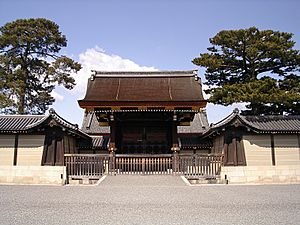Imperial Court in Kyoto facts for kids
Quick facts for kids Premodern Japan |
|
|---|---|
 |
|
|
Daijō-kan
(Council of State) |
|
| Daijō-daijin | |
| Minister of the Left | Sadaijin |
| Minister of the Right | Udaijin |
| Minister of the Center | Naidaijin |
| Major Counselor | Dainagon |
| Middle Counselor | Chūnagon |
| Minor Counselor | Shōnagon |
| Eight Ministries | |
| Center | Nakatsukasa-shō |
| Ceremonial | Shikibu-shō |
| Civil Administration | Jibu-shō |
| Popular Affairs | Minbu-shō |
| War | Hyōbu-shō |
| Justice | Gyōbu-shō |
| Treasury | Ōkura-shō |
| Imperial Household | Kunai-shō |
The Imperial Court in Kyoto was like the main government of Japan for a very long time. It was located in Kyoto (which was once called Heian-kyō). This court was the center of power from 794 AD until the Meiji period, which began in 1868. After 1868, the court moved from Kyoto to Tokyo (which used to be called Edo). In Tokyo, it became part of the new Meiji government.
Contents
The Imperial Court in Kyoto: Japan's Ancient Heart
The Imperial Court in Kyoto was more than just a place where the emperor lived. It was the heart of Japanese politics, culture, and economy for many centuries. Important decisions were made here. Many skilled artists, writers, and thinkers also gathered at the court, making Kyoto a vibrant cultural hub.
Why Kyoto Became the Capital
The decision to move the capital to Kyoto was made by Emperor Kanmu. He lived from 737 to 806 AD. Before Kyoto, the capital was in a place called Nagaoka. There had been some disagreements about who should rule during the earlier Nara period. Emperor Kanmu wanted a fresh start.
Kyoto was chosen because people believed its location was very lucky. It had the right number of rivers and mountains around it. These natural features were thought to bring good fortune to the new capital. The city itself was designed to look like Chang'an, which was the capital of China's Tang dynasty. Its layout followed ancient ideas about balance, known as yin-yang.
Who Ruled the Court?
The most important group of people at the Imperial Court was the civil aristocracy. These noble families were known as the kuge. They were the leading class in society. The kuge helped the emperor govern the country. They held important positions and had a lot of influence over daily life and big decisions.
The Rise of the Shoguns
After the year 1185, the power of the Imperial Court in Kyoto began to change. A new system of government started to grow. This was called the shogunate system. Gradually, the shoguns began to take over the actual running of the country from the emperor.
Minamoto no Yoritomo and the Kamakura Shogunate
Minamoto no Yoritomo was a powerful military leader. In 1192, he became the first person to hold the title of shōgun. He made sure that this position would be passed down in his family. This meant that the shoguns, not the emperors, held the real political power in Japan.
The shoguns were so powerful that people from Western countries sometimes thought they were the emperors of Japan. Yoritomo's government was known as the Kamakura shogunate. It lasted for nearly 150 years, from 1185 to 1333. During this time, the shoguns made most of the important decisions for Japan.
See also
 In Spanish: Corte Imperial de Kioto para niños
In Spanish: Corte Imperial de Kioto para niños
- Five regent houses
- Heian Palace
- Kyoto Gosho


